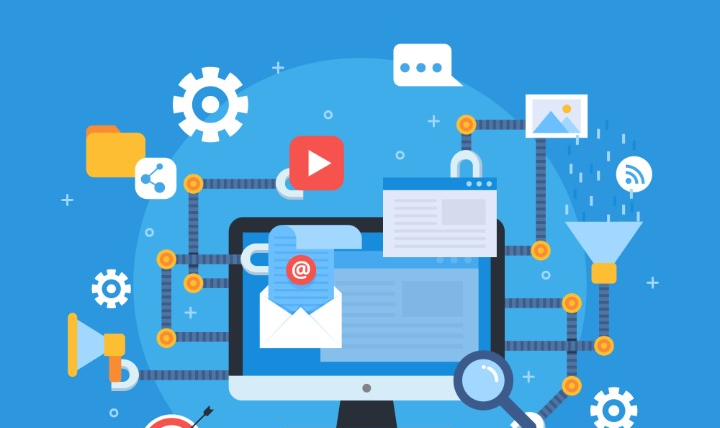Imagine you’re eagerly waiting in line for your favorite music concert. As you inch closer to the gate, the anticipation builds, knowing that once you pass through those gates, an unforgettable experience awaits.
Generating that anticipation is the purpose of gated content in the marketing context. Just like a concert gate separates you from your favorite music star, gated content keeps valuable information just a step away.
In marketing, instead of a ticket, it’s the visitors’ contact details that grant access to the information. And with automation, this process becomes even smoother, ensuring that no fan—or potential lead—is left waiting too long. Gate content is a great way to build anticipation, generate value, and generate leads.
What is gated content?
Gated content is valuable content that you offer to your website visitors in exchange for their contact information, usually an email address. Time is money. Imagine you have spent your valuable time on a new process, a helpful guide, or a useful video. Instead of letting everyone have it right away, you restrict access with a “gate”, a form in front of it.
When people fill out the form, they’re showing real interest. This means the visitor is interested in your services or products. By collecting their information, you get a chance to reach out to them later, maybe with a friendly email sharing more about your business or other helpful resources. This process of collecting details is called lead generation.
For businesses, gated content is a valuable marketing tool. By giving away high-quality content in exchange for contact details, you can build a list of potential customers. Over time, as the list grows, you connect with and build relationships with these leads, turning them from interested visitors into loyal customers.
What are different types of gated content?
Gated content comes in various types and forms. Here are some of the most common content types:
Ebooks and Whitepapers
Ebooks and white papers are detailed guides or reports on a particular topic. This content usually involves extensive research, writing, and visual aids. This content often saves the user considerable time or money.
For example, a business might offer an ebook on “10 Steps to Improve Home Gardening.” People looking for in-depth information on the subject can share their email details in exchange for such a comprehensive guide.
Online or in-person events
Businesses often conduct webinars or product demos offering education and insights, often by experts in the particular field. Users interested in attending those events can register for the event using their email address.
Case Studies
Case studies provide real-life examples of how a product or service helped a customer. Case studies highlight the customer’s specific problem and highlight how the product or service solved the problem. Customers having a similar problem might be interested in reading it by sharing their details.
Templates and Toolkits
These are pre-built, easy-to-use resources that can save people time and effort, making them attractive pieces of content. For example, a marketing website might offer a social media planning template or a branding toolkit that can help get started with social media marketing effortlessly.
Research Reports
Enterprises often conduct studies or surveys in their industry and compile the results into research reports. The studies may include market trends, industry forecasts, and valuable insights. People interested in those articles can share their contact details to access the materials.
Exclusive Videos
This could be interviews with experts, product demonstrations, or other informational content presented in video format. Since videos can be engaging and easy to digest, many people find them valuable.
Software Trials or Demos
For businesses selling software or digital tools, offering a trial version or a demo of their product can be a form of gated content. This allows potential customers to test out the product before deciding to purchase it.
How is gated content used in lead generation?
Gated content usually comes into play in the “awareness” and “consideration” stages of the sales funnel.
In the “awareness” stage, people are just discovering a brand or a product. Gated content, like an informative e-book or a research report, can help introduce them to the business and its expertise.
As they move to the “consideration” stage, they’re thinking about solutions to their problems and comparing options. Here, gated content like webinars, case studies, or software trials can offer deeper insights and showcase the value of a product or service
By providing gated content, businesses can collect the contact details of potential customers and nurture them through the rest of the funnel, guiding them closer to making a purchase decision.
How does gated content work?
The key aspect of gated content is that it creates a win-win situation: visitors get valuable content, and businesses get the opportunity to build relationships with visitors, who can turn into loyal customers.
Before creating any content, it’s crucial to understand the target audience—who are they, what are their interests, needs, or problems? Understanding your target audience helps you craft the right type of content that generates interest and anticipation, just like when you’re waiting in line for a music concert.
Here is the step-by-step process for setting up proper gated content lead generation.
Step 1: Create high-quality content. Once you’ve identified your target audience, create content tailored to their interests. This content should offer real value, whether it’s educating them on a topic, providing insights, or solving a problem they might have. Remember, the higher the quality of your content, the more likely people are willing to share their details to access it.
Step 2 – Setup a Landing Page: A landing page is where your target audience will come to access the gated content. This page should clearly describe the benefits of the content you’re offering. Use compelling headlines and clear descriptions. The goal is creating the curiosity and eagerness to access your content.
Step 3 – Set Up the Gate: The “gate” is typically a form that visitors fill out to access your content. The form could ask for details like their name, email address, and perhaps job title or company name. It’s essential to keep this form as simple and straightforward. The easier it is to fill out, the more likely people will use it.
Step 4 – Integrate with a CRM: When the visitor fills out the form, their details should be stored in a safe and secure place. Tools like Customer Relationship Management (CRM) systems or email marketing platforms such as MailChimp can help store these details and allow for future communication with these potential customers.
Step 5 – Deliver the Content: After the form is submitted, ensure the user receives the promised content. This can be achieved by directing them to a download link, sending the content via email, or providing access to a special area on your website. Make sure this process is smooth and hassle-free.
Step 6 – Follow-ups: Now that you have the contact details of prospective customers, it’s time to build a relationship with them. Send follow-up emails offering additional value, whether in the form of more content, updates about your products or services, or special offers. The idea is to keep them engaged and move them closer to becoming customers.
The power of gated content automation
As highlighted earlier, there are at least six steps in the gated content process. Managing this process manually is very tedious as each time when a visitor wants to access your content, someone has to collect, store, and share the content appropriately. This not only consumes your precious time, but it is also error prone. Misplacing contact details, forgetting to send the promised content, or not following up at the right time, leads to missed opportunities.
Automating the process can help the lead generation process smoother. With the right tools, the automated process can direct the user to the right landing page and the gated form. As soon as the user submits their details, the system automatically stores the information in the integrated CRM or email system, and instantly delivers the content to the user. No delays, no errors, or missed opportunities. Additionally, the process can be further automated to send follow-up emails, ensuring there is constant communication with the prospective customer.
Automating the process, not only saves valuable time and resources, but also ensures a smooth and consistent user experience for each visitor, every time.
Summary
he gated content is one of the key tools frequently used by successful businesses in generating leads. With the proper content, you can attract, nurture, and convert into loyal customers. As highlighted, in order to automate the process, you need various digital assets and tools. If you need any assistance in setting up the process or automating, contact Minutly, we can connect you with the right service or service provider.








How to launch your web application development service
Fractional CXOs : Complete Guide – How to start, scale, and grow your fractional business
What is a Service Catalog?
How to start a Generative AI Service: A Comprehensive Guide (2024)
What is a Service Catalog?
Top 10 Essential Sales Service Requests Every Business Should Offer
Sharing your Minutly Catalog
Setting up your catalog